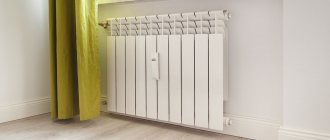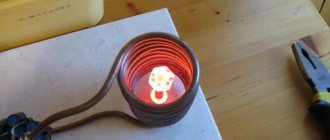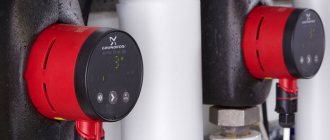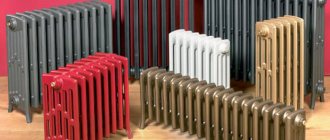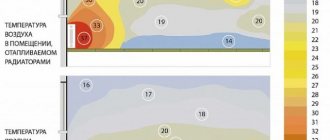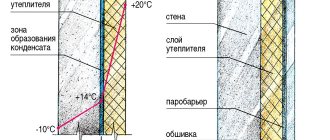How to correctly calculate power consumption
The amount of electricity consumed by household appliances, lighting, heating, air conditioning and ventilation directly affects the amount of payment for electricity.
Any equipment absorbs energy in the amount of the corresponding power of the device. This important characteristic is the basis for calculating electricity consumption. How to calculate the power consumption of electrical appliances and determine the electricity consumption are questions that are answered in this article. Electricity consumer connection:
Origin of the unit of measurement kilowatt/hour
The intensive study of electricity by European scientists began around the 17th century, at which time fundamental discoveries were made that marked the beginning and development of such a science as electrical engineering. Scottish engineer, mechanical inventor (1736–1819) James Watt introduced into use the first unit of power - horsepower.
Portrait of James Watt:

In 1782, the British Association of Engineers assigned the scientist's name to the unit of power meter - Watt. It must be borne in mind that in Russian the English letter “W” has a double reading, like “V” or “Ua”. Therefore, we read the name of the inventor as Watt, and the unit of measurement is Watt. In 1889, the unit of measurement gained worldwide recognition. Only in 1960, “Watt” officially entered the international SI system as a power meter for any type of energy, be it thermal, mechanical or electrical.
The energy consumption consumed over a certain period of time is measured in W/h. To reduce the number of symbols when indicating the power consumption of an electrical appliance, a unit such as kilowatt/hour - kW/h (1000 Wh) was introduced into use.
Determination of power consumption
Calculating electricity consumption by power can be done in several ways. They are described below.
Nameplate data
Over time, a generally accepted practice has developed - to indicate the technical parameters of household appliances on nameplates. To find out the power consumption, just read the data on the plate.
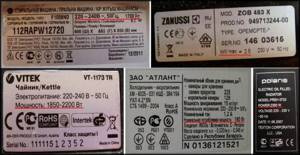
Calculation by formula
Knowing the voltage in the current source (household outlet, batteries or accumulator) and the current that the device consumes, there is nothing easier than determining the power consumption of an electrical device. In this case, the calculation formula will look like this:
N = VxI. Where N is power (W); V—voltage (V); I - current strength (A).
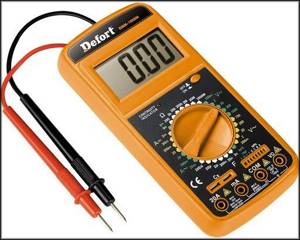
For example, using a multimeter in ammeter mode, they find out the current strength for which the electric saw is designed - 8.2 amperes. Since the equipment operates from a household power supply of 220 volts, it will be quite simple to calculate the power consumption of the saw: 220 × 8.2 = 1800 W = 1.8 kW.
Circuit for measuring current with a multimeter:

Measurement with a wattmeter
This is a universal way to calculate electricity consumption using such a device. Currently, it is quite easy to purchase it online in one of the Chinese online stores.

Wattmeter is a power meter for various electrical consumers. The device determines the power characteristics of a device for any purpose operating from a household electrical network. On its back there is a plug that is inserted into the socket. In the front part of the case, under the display, there is its own socket. The equipment under test is connected to it.
Using this tester is one of the ways to calculate the electricity consumption of any household electrical appliance. The power meter is a kind of bridge that connects the consumer with the current source. They take measurements over a certain period of time. Then you can calculate how much money a refrigerator or washing machine “spends”. The tester has a built-in battery, which is needed to remember previously obtained readings and calculate the monetary costs for consumed electricity. In other words, a wattmeter can be characterized as an individual electric meter that serves one electrical appliance.
Elimination method
With this method, the electric meter acts as a power meter. Let’s say that there is electrical equipment in the house that does not have a nameplate, the documentation for it has long been lost or did not exist at all. There is the easiest way to calculate electricity consumption - this is the elimination method. Proceed as follows: de-energize all appliances in the apartment or house, turn off the lights, and turn the block toggle switches on the electric meter to the “Off” position. except one.
Taking electric meter readings:

The desired device is turned on for as long as possible. The amount of electricity consumed for 1 hour should be recorded. If circumstances do not allow this, then switching on is carried out within a time period that is a multiple of 60 minutes.
For example, if the equipment worked for 10 or 20 minutes, then the result is multiplied by 6 or 3 accordingly. If the device consumed 800 W within an hour, this means that its power is 0.8 kW/h. If you display the average number of operating hours of an electrical consumer per month, you can determine the costs that this equipment brings. To do this, the indicator is multiplied by the cost of 1 kW/h.
Power consumption calculator
You can use an online calculator as a power meter. One of its options can always be found on the Internet. The main purpose of the network service will help you determine the power of all electrical consumers located in a house, apartment or office. The results obtained are indicative in nature, but with their help you can calculate the electricity consumption of different types of consumers.
Using the calculator, homeowners can calculate future energy costs. Knowing the weak points in the overall picture of energy consumption, you can optimize the operating mode of the main electrical appliances. This can bring significant savings to the family budget.
The calculator is easy to use. The relevant data about lighting devices is entered into the interface windows - the power and number of lamps of different types, then information about electrical appliances is entered: a refrigerator, a TV, a washing machine and other household appliances, a computer, related office equipment and various power tools. After this, the current electricity tariff is entered into the “Cost of 1 kW” window. By clicking the “Calculate” button with the cursor, you get the estimated value of energy consumption for the month, as well as the amount to pay for electricity.
Advantages and disadvantages of using electricity for heating purposes
It should be noted right away that using electric heaters for heating is not the cheapest option, since the cost of the equipment itself, as well as operating costs, are too high. Therefore, it is most often considered as an alternative, in case of interruptions in the gas supply or, if there is no gasification at all. At the same time, heating a house using electrical appliances has some obvious advantages:
- Almost universal availability.
- Very fast and easy installation.
- Convenient controls.
- Compact device design.
- Complete absence of any combustion products.
Thus, despite all their shortcomings, associated mainly with the economic component of the issue, electrical appliances have a lot of useful qualities that heating devices based on fuel combustion cannot boast of.
What is power consumption?
Power consumption is a numerical measure of the amount of electrical energy required for the operation of an electrical appliance or converted by it during operation. For static devices (stove, iron, TV, lighting), current energy turns into heat during operation). During conversion (electric motors), the energy of electric current is converted into mechanical energy.
The basic unit of electrical power is Watt, its numerical value
where U is voltage, Volts, I is current, amperes.
Sometimes this parameter is indicated in V×A (V×A for imported equipment), which is more correct for alternating current. The difference between Watts and VA for household networks is small and can be ignored.
Electrical power consumption is important when planning wiring (the cross-section of the wires depends on it, as well as the choice of ratings and the number of circuit breakers). During operation, it determines the costs of maintaining the home.
Household products
The category of electric heating devices also includes all kinds of household items that we use, if not daily, then quite often.
In particular, ironing products such as special machines and electric irons. Devices that heat water are also widely used - these are immersion boilers, and instantaneous and storage type water heaters.
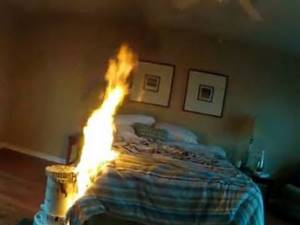
Heating elements include devices for welding and burning, vulcanizers, soldering irons and much more. Household appliances are also used for drying hair (hair dryers) and for clothes (dryers, stands, special sliding curtains).
The problem of proper operation of the household electrical network
From a constructive point of view, the household electrical network has been developed to a high degree of perfection: its normal operation does not require special knowledge.
The network is designed for certain operating conditions, the violation of which leads to complete or partial failure, and in severe cases, to a fire.
The condition for proper operation is the absence of overload.
At the same time, the load capacity of sockets and the consumption of equipment connected to them are measured in different units:
- for sockets this is the maximum permissible alternating current (6 A for traditional Soviet sockets of old housing stock, 10 or even 16 A for European-style sockets);
- connected equipment is characterized by power, which is measured in Watts (for powerful devices, larger units are indicated instead of Watts: kilowatts (1 kW = 1000 W), which allows you to avoid confusion with numerous zeros).
Hence the need arises:
- determining the relationship between power and current;
- finding the power of an individual electrical appliance.
The relationship between Watts and Amps is simple and follows directly from the definition of Watt above. The task is simplified by the fact that the voltage of a working household network is always the same (220 or 230 V). From here, power is always found along the current.
Devices depending on the heating product
According to this classification, electrical appliances are divided into water heating and air heating.

But it will also not be completely complete, because some equipment is difficult to classify as the first or second group. For example, microwave or electric ovens. Therefore, the first classification is the most accurate, where electric heating devices are classified according to their purpose.
How to determine?
To solve the problem of finding power, you can use various methods. All of them are available for use even with knowledge of physics and electrical engineering at the school curriculum level.
More often, power is found by determining the current; sometimes you can do without intermediate procedures and determine it immediately.
We look at the technical passport
Typically, the power consumption is indicated in the passport or description of the device and is duplicated on the nameplate. The latter is located on the rear wall of the case or its base.
If there is no description, this parameter can be found on the Internet, for which you just need to search by the name of the device.
The power indicated by the equipment manufacturer refers to peak power and is consumed from the network only at full load, which is quite rare. The resulting difference is considered as a reserve. At the regulatory level, this reserve is determined through the power factor.
Ohm's law to help
The power of most household electrical devices can be fairly accurately estimated experimentally and by calculation using Ohm's law, known since high school. This empirical law relates voltage, current and load resistance R as:
P = U 2 /R. U = 230 V, and the resistance is measured by a tester. The following is a simple calculation using the formula P = 48,400/R W.
For example, with R = 200 Ohm we obtain power P = 240 W.
The method does not take into account the so-called reactance of the device, which is created primarily by input transformers and chokes, and therefore the resulting estimate is somewhat overestimated.
We use an electric meter
When determining power from a meter, you can proceed in two different ways. In both cases, only the device under test should be powered from the household network. Without exception, all other consumers must be disconnected.
In the first approach, an optical meter indicator is used to measure power, the intensity of its flashes is proportional to the power consumption. The proportionality coefficient is indicated on the front panel in units imp/kWh or imp/kWh, Figure 1, where imp is the number of pulses (indicator flashes) per kilowatt hour.

Figure 1. Front panel of a household electricity meter with optical indicator
After turning on the device under test, you must begin counting the indicator flashes for 15 or 20 minutes. The resulting value is then multiplied by 3 or 4 (for a 20- or 15-minute measurement interval, respectively) and divided by the coefficient from the front panel. The result of the calculation gives the power of the device in kW, which in some cases is conveniently converted into Watts by multiplying by 1000.
Example. For the counter we have k = 1600 pulses per kilowatt hour. With a 20-minute measurement interval, the indicator worked (flashed) 160 times. Then the power of the device will be 160*3/1600 = 0.3 kW or 300 W.
The second approach also uses a 15- or 20-minute time interval, but the energy consumption is determined on a digital scale. For example, with a difference in readings over 20 minutes of 0.2 kW×hour, the power of the unit is 0.2 × 3 = 0.6 kW or 600 W.
Direct current measurement
The methods of that group are characterized by higher accuracy due to the fact that they are based on direct measurement of current. There are two devices for performing this procedure at home.
Metering with current clamps
The most convenient to use are current clamps that do not require breaking the controlled circuit. Designed as a hand-held device with a measuring unit based on a toroidal core. To measure the current, the assembly is opened in the manner of pincer sponges, and then closed to cover the wire, Figure 3. The effective value of the current is determined by the change in the magnetic field, which is recorded by the Hall sensor.
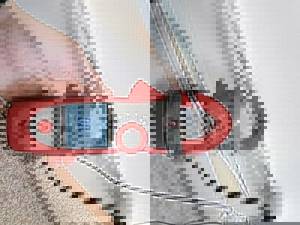
Rice. 3. Measurement with current clamps
Measurement with a tester
The second method is based on the use of a tester, which is switched to ammeter mode and connected to an open circuit. The difficulties of implementing this procedure using simple means make it little popular in practice. We also cannot discount the fact that some tester models do not have current protection and fail (burn out) if the range is incorrectly selected (current overload).
What can you cook with?
You can cook and heat various types of dishes using microwave ovens, floor-standing and portable appliances, food warmers, as well as special devices for heating baby food.
To cook something or prepare drinks, we usually use:
- teapots;
- coffee pots and coffee makers;
- samovars and much more.
Kettles can have a body made of aluminum, plastic or brass. The heater is most often tubular and placed inside. For better heat transfer, it can be pressed with a disk or screw to the inner bottom.
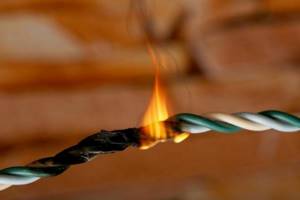
The coffee pot is slightly different in shape and is also equipped with a special geyser. The heating element is located in the double bottom of the device. But the coffee maker is designed for preparing drinks under pressure. It includes two vessels. One is for boiling water, and the second is for collecting the finished drink. Water is heated and pressurized through the coffee from one container to another.
Samovars are currently practically not used; most often they are a decorative element of the interior in the national style. They have a traditional shape and are made from brass.
How to calculate the thermal power of convectors, heaters and other heating devices
Thermal engineering calculation is the calculation of the required thickness of floors in accordance with the thermal insulation characteristics of materials and the power of heating devices. To create comfortable conditions during the cold season, any room requires a certain amount of heat, and it doesn’t matter whether the heating system of a private house is being designed or whether only one room needs to be heated - calculations are necessary.
All heating devices, regardless of the type of device (convectors, radiator batteries, heaters, heat guns, etc.) and the type of coolant (water, gas, electric), heat rooms and the heat they produce is called thermal power. It is this characteristic that is of utmost importance when choosing a heating device.
For example, it is impossible to heat a workshop with an area of 20 m2 and built without thermal insulation at -15 0 with an electric heater with a power of 1 kW, and a small bathroom located in the center of a brick house is easily impossible.
The amount of heat that a room requires for heating is measured in kilocalories, and the power of devices is measured in watts, so to convert one value to another you need to divide kilocalories by 860 and you get kW.
All manufacturers of heating equipment must indicate the thermal power of the device in the passport or instructions. However, it should be taken into account that the specified power is achieved subject to all operating conditions, i.e. For water convectors or radiators, the coolant temperature matters, and for gas appliances, the gas pressure matters.
Therefore, in addition to the heating power, manufacturers indicate for what operating conditions the equipment is intended.
For example, if you have an old central heating system with a heating temperature of 40-50 0 C, it is recommended to purchase convectors for low-temperature heating systems.
Requirements for operation and installation
Contacts with this type of equipment must be carried out in accordance with the requirements of special regulatory documents. This applies to its design, installation and commissioning. Moreover, we are talking not only about the household products themselves, but also about electrical networks and installations.
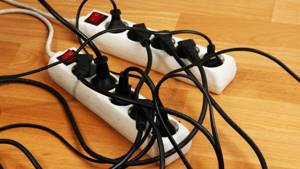
If we talk about residential premises, then products can be left energized if the instructions allow this or this is their purpose.
Do not allow the laying or use of overhead transmission lines near flammable roofs or canopies, as well as warehouses with explosive substances and products.
The simplest calculation of the thermal power of a heater
There is a generally accepted standard for calculating the thermal power of a heater for a room height of no more than 3 m. For 10 square meters of area, 1 kW of device power is installed.
This formula works well when calculating electric heating devices in rooms with ideal conditions - high thermal insulation, minimal heat loss and one window with insulated double glazing. But there is also a primitive calculation option that allows you to take into account the height of the rooms.
Simple calculation of the thermal load (Q) of a room:
V (room volume/m3) x 40 W/1000 = Q (kW/h)
This formula does not allow errors associated with rough calculations based on the principle of 1 kW per 10 m 2 because it takes into account the volume of the room including the height of the ceilings. However, even with such a calculation, it is easy to make a mistake and purchase a “weak” device - many important factors are not taken into account.
Calculation example
Input data: living room in a private house, HxWxD - 4x5x6 m.
Using the first formula, we find out the area of the room - 5x6 = 30 m2 and multiply by 1 kW. It turns out that we will need a 3 kW heater.
But these calculations do not guarantee that by purchasing a 3 kW heater, you will get a comfortable temperature in the room - such a primitive calculation does not even take into account the temperature outside the window. If in the middle zone 3 kW can and will cope with heating such a living room, but in the north with -35 outside the window, you can be sure that you will be disappointed with the purchase and chattering teeth.
Using the second formula, we find out the volume of the room - 4x5x6 = 120 m3.
V x 40 W/1000 = 120 x 40/1000 = 4.8 kW
As you can see, the second formula more accurately reflects the necessary heat demand of the room. In addition, keep in mind that these calculations are usually used in electric heaters, and with a device with a power of 5 kW per hour you will go broke on your electricity bills, and not all the wiring will withstand such a load.
Fire safety requirements
To prevent fires, follow these rules:
- do not use power receivers in places and conditions that do not comply with the requirements of the instructions from their manufacturers;
- do not use defective products that may cause a fire;
- do not operate wires and cables with damaged insulation or without protection;
- Broken sockets, switches and other products cannot be used for their intended purpose;
- do not wrap lamps and luminaires with paper, fabric bandages and other flammable materials; it is prohibited to use light sources without caps, if they are provided for by their design;
- It is prohibited to use tiles, irons, kettles and other electric heating devices if they do not have thermal protection and stands based on heat-insulating non-flammable materials that can prevent fire;
- do not use homemade devices, uncalibrated fusible links and other non-standard short circuit protection products;
- do not place or store flammable and flammable substances and products near switchboards, engines and starting equipment;
- If the room is explosive, then you cannot use all types of household appliances in it.
However, knowledge of fire safety rules cannot always protect against fire. Naturally, you need to use all electrical appliances in accordance with existing requirements in order to prevent damage to property and more serious consequences.
If a fire does occur, it can be stopped in time by calling the fire department on numbers 01 or 010. There is also an emergency number 112, which can be called even from a mobile phone when there is no money on it and even in the absence of a SIM card .
However, it is better to avoid such situations. To do this, when purchasing a product, carefully study its instructions so as not to purchase a defective product. Remember that the use of electric heating devices should not lead to unpleasant consequences, but be beneficial.
Formula for calculating the thermal load taking into account the temperature difference
To more accurately determine the required thermal power of a heater or convector, we recommend using the following formula.
V (room volume) x T (temperature difference) x φ (heat loss coefficient) = kcal/h
- V is the volume of the room mentioned above: width * length * height.
- T (temperature difference) - depending on the climatic zone, the temperature outside can be either -5 0 C or -30 0 C. Therefore, a parameter has been introduced into the formula that expresses the difference between the average winter temperature outside and the desired temperature in the room. Example: the average winter value outside is -15 0 C, and in the room 25 0 C is required - it turns out T = 40 0 C.
- φ – coefficient of heat loss of premises depending on the design and insulation. 3-4 – lack of thermal insulation. Simple wooden or metal buildings without insulation.
- 2-2.9 – low thermal insulation. Single brick masonry, simplified building design, single windows.
- 1-1.9 – average thermal insulation. Buildings with two bricks, standard buildings, ordinary roofing, a small number of windows.
- 0.6-0.9 - high thermal insulation. Few windows, double glazing, brick walls, double insulation, insulated roof and thick subfloor.
Formula for calculating thermal power taking into account additional factors
Despite the introduction of the heat loss coefficient, the previous formula is not able to reflect all kinds of nuances of the premises. For example, the heat loss of an apartment located on the 5th floor in the center of a nine-story building is lower than that of a corner apartment on the top floor. To obtain more accurate data, we recommend using the formula:
Q = (100 W/m 2 x S x φ 1 x φ 2 x φ 3 x φ 4 x φ 5 x φ 6 x φ 7)/1000
- S is the area of the room in m2.
- φ 1 – heat loss through windows: 0.85 – triple glazing;
- 1 – double glazing;
- 1.27 – single glass unit (standard).
- 0.854 – high;
- 1,2 – 50%;
- 1.5 – -35 0 C;
- 1,4 -4;
- 0.8 – heated;
- 1.2 – 4.5m;
As you can see, the formula for calculating the thermal power of heating equipment takes into account significantly more values that affect heat loss.
Calculation example
Input data: living room in a private house, HxWxD - 4x5x6 m. The house was built with two bricks, on an insulated foundation with a large panoramic window, with standard glazing, occupying 50% of the floor area. The average temperature in winter is -15 0 C. On the second floor there are heated bedrooms, two walls face the street.
We find out the required values and coefficients:
- S – 30m2.
- φ 1 – 1.27.
- φ 2 – 1.
- φ 3 – 1.2.
- φ 4 – 0.9.
- φ 5 – 1.2.
- φ 6 – 0.8.
- φ 7 – 1.15.
Substitute the values into the formula:
Q = (100 W/m 2 x S x φ 1 x φ 2 x φ 3 x φ 4 x φ 5 x φ 6 x φ 7)/1000
Q = (100 W/m 2 x 30 x 1.27 x 1 x 1.2 x 0.9 x 1.2 x 0.8 x 1.15)/1000 = 4.543 kW
Based on this refined calculation, it turns out that we need to organize heating at 4.5-5 kW.
This formula is preferable for calculating the thermal power of heating systems, and it is suitable for calculating heating in small residential premises and in organizing the heating of industrial facilities.
Important! To increase the service life of thermal equipment and to take into account unforeseen situations, it is recommended to add a small margin of 10-15% to the received thermal power.
